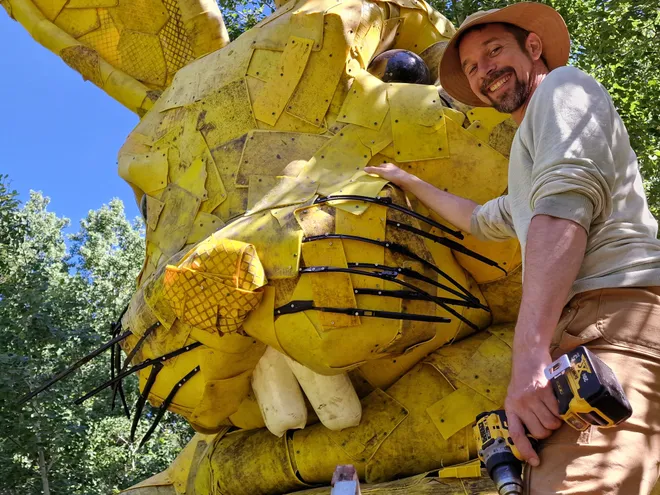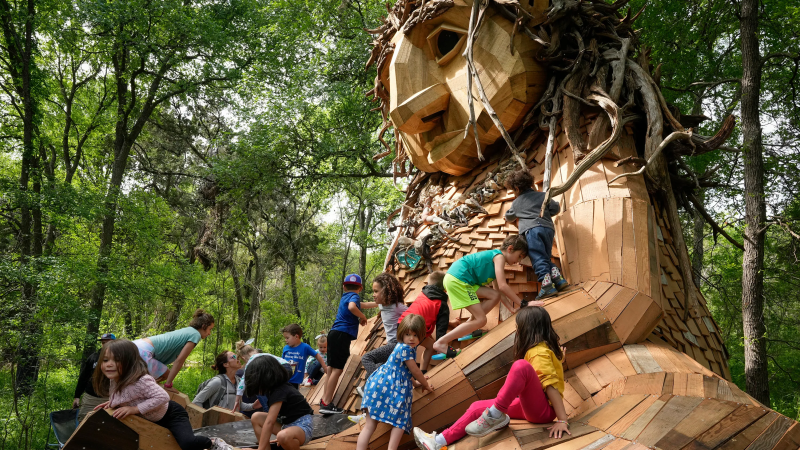From trash to trolls: This artist is transforming American garbage into mythical giants
Trolls, the menacing otherworldly beings of folklore, are gaining a foothold across America. They haven’t gobbled anybody up yet, but they still hope to shake everyone who meets them to their core and deliver a new message: Trash is treasure.
“It’s an advertising campaign for trash,” quips Thomas Dambo, the Dr. Frankenstein to over 150 troll sculptures around the world. “I want trash to be the fashion, I want it to be cool, because if it was cool then we would be less wasteful.”
The Danish self-described “garbage artist” has been crafting giant trolls from refuse – mainly old wood pallets – for about a decade. The 5-ton sculptures haunt over a dozen countries and U.S. states. He completed his most ambitious troll installation – five trolls plus other giant sculptures – in Detroit Lakes, Minnesota, in June.
Whimsical names, lighthearted stories and the intricate craftsmanship involved in making the trolls give creatures like Ronny Funny Face a broad appeal. But beyond enjoying the sight of them, Dambo hopes viewers will also note how the trolls were made from disregarded materials and appreciate the precious environments they inhabit, from Jackson Hole, Wyoming, to forests near the demilitarized zone in South Korea.
“It’s a cute little fairy tale about a troll but if you look deeper, it’s a story about humans and recycling and how we care for the world,” said the 44-year-old. “I don’t want to just make entertainment. I want to make ‘edu-tainment.’”
Dambo spoke to USA TODAY on video from his studio outside Copenhagen, where he directs dozens of employees in designing the cute-as-a-button monsters. His so-called customers are people from around the world who want him and his merry band to transform garbage into something mystical.
Politicians haven’t passed any “Thomas Dambo laws” protecting the environment, the Dane jokes. But he sees proof of his concept in the life he’s built on garbage and trusts some of the millions encountering his work leave with a new sense of resolve.

Where are the trolls?
Ronny Funny Face, Barefoot Frida and Jacob Everear are among the latest Dambo creations. The artist, his crew and dozens of volunteers built and installed them along with several other sculptures in Northern Minnesota in June.
Project 412, a Detroit Lakes nonprofit aiming to boost the town’s cultural cache, commissioned the project.
“Public art adds to a community in a way that’s equally as important as having a good library or having a great downtown. All of those are gems in the necklace that make a community shine,” said Amy Stearns, the nonprofit’s executive director. The name 412 is a reference to all of the lakes in the area.
The group took to his work because of its awesome appearance and sustainability ethos.
“He’s shining a light on how important it is for us to care for our world, our natural resources,” Stearn said. “Public art can move the needle.”
Project 412 also hopes the giant trolls - one stands 40 feet tall - will draw visitors to small town Minnesota.
The creatures have had an outsized impact on the other places they’ve landed.
Gretchen Osther, CEO and President of the Coastal Maine Botanical Gardens, said visits to the Boothbay Harbor destination have more than tripled since Dambo installed trolls in 2021.
The number of visitors shot up from 100,000 in 2019 to 340,000 today. Osther said the increase is partly because tourism has grown in Maine generally, but also because of the trolls’ ability to reach new audiences.
The Maine institution began planning to bring in Dambo’s work in 2019 after seeing the impact it had on botanical gardens in Kentucky and Illinois, where leadership told her the trolls boosted visitors tremendously and attendance remained high even after they were dismantled.
Dambo’s patrons call this the “troll effect,” said Osther.
The trolls in Maine are called the Guardians of the Seeds in reference to protecting native trees. But the impact of the trolls is that they gave the institution the cash flow to do more than they’ve ever done before to protect local flora, according to Osther.
“We were hardly doing any of that before the trolls arrived,” she said. “We didn’t have the funds to invest in that like we wanted to. But the more people we see here, the more we can.”
Both Stearns and Osther didn’t disclose how much installing the troll cost. But Osther said they have paid for themselves “100 times over.”
Dambo maintains a map of where the trolls are located on his website.
Why trolls?
Dambo’s answer to why he began to make trolls as opposed to anything else is simple: No one had seen a real one.
“Animals, they’re hard to build because they have to really look like animals,” said the artist. “This is much easier because I’m the only one who knows how they look.”
Trolls also play a big role in Scandinavian cultures. Growing up, Dambo remembers buying troll figurines, his mom telling him a troll put a large stone in the garden, or how biking up certain hills was hard because a troll tugged at riders' clothes.
Traditionally, the role the beings play isn’t so nice.
“They attack you and kill you and, presumably, drag you to hell with them,” said Ármann Jakobsson, the author of a book on trolls and professor of Old Icelandic Literature at the University of Iceland. They were undefined figures of terror more comparable to Michael Myers.
Dambo’s trolls are “not very traditional,” the scholar said. “They’re not very terrifying; they’re very ‘cutified.’”
But he saw some consistencies in the artist’s repurposing of the otherworldly creatures to fit new narratives as well as their aim of shaking people to their core.
“The impact a troll has upon a person is what makes it interesting,” Jakobsson said. “The troll is now warning against what we’re doing to ourselves.”

Dambo grew up in a dump
Dambo’s garbage art practice began when he was a child. He had nowhere or no way to buy toys, so he made them, sneaking away with things from the local trash before dumpster diving had even become a thing.
He also enjoyed building things. He recalls when he was a preteen and his dad built him a fort from scrap wood. Instead of playing in it, Dambo’s reaction was wanting to make one of his own.
So, dad’s fort became a chicken coop and over the next five years, Dambo embarked on building his own extensive fort with his friends.
His mother tells stories to this day of watching him corral the group into completing just one more piece of the castle.

Decades later, Dambo feels he’s still doing the same thing by hanging out in the wood, turning stories into reality through garbage with friends.
“I love these small universes,” he said. “That’s always been my appeal, build something out of nothing and make it really magical.”
Disclaimer: The copyright of this article belongs to the original author. Reposting this article is solely for the purpose of information dissemination and does not constitute any investment advice. If there is any infringement, please contact us immediately. We will make corrections or deletions as necessary. Thank you.





